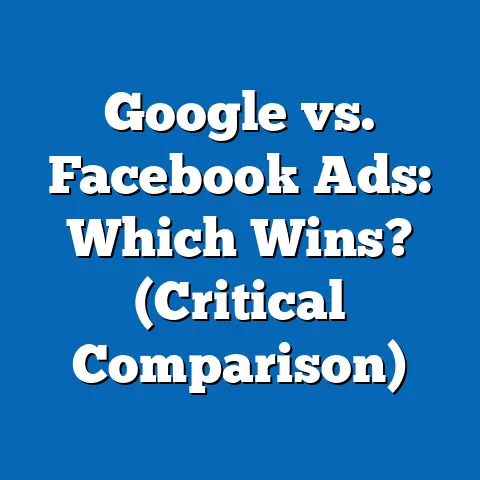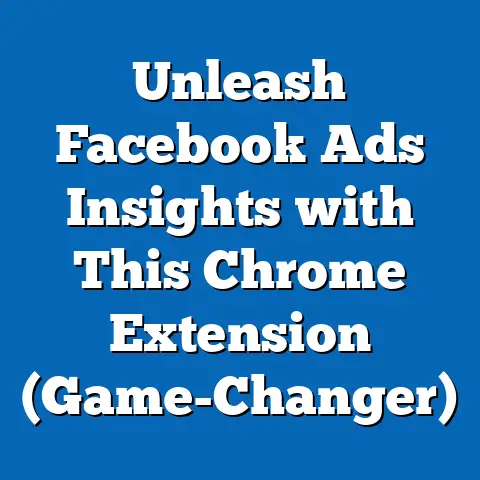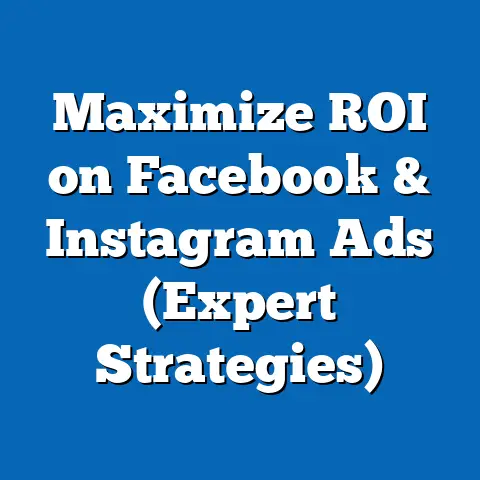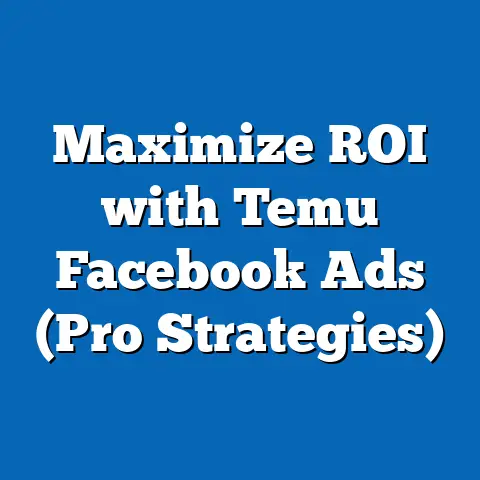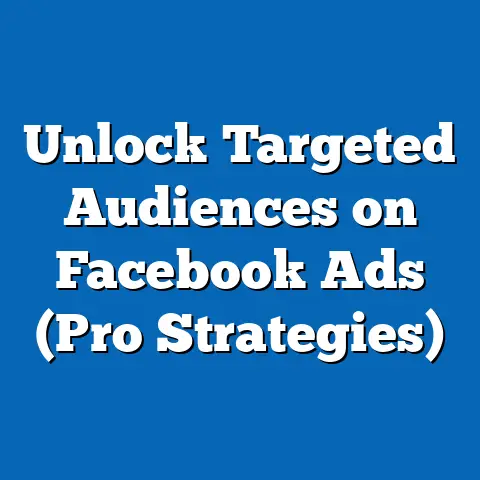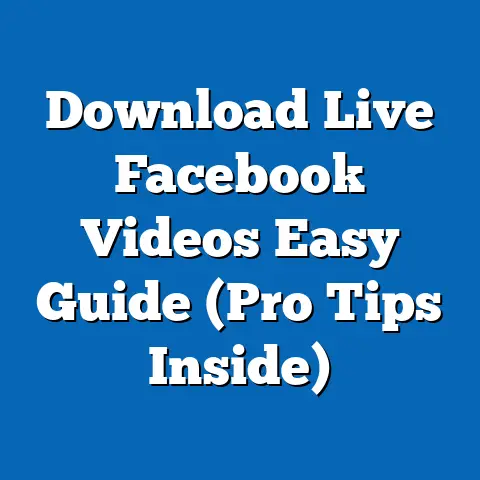Cut Facebook Ads Costs Fast (Expert Strategies Inside)
In today’s digital age, a robust advertising budget is the lifeblood of any thriving business. However, simply throwing money at advertising isn’t enough; durability is key. We need to build advertising strategies that can withstand the test of time, adapt to market changes, and, most importantly, remain cost-effective. On platforms like Facebook, where competition is fierce and costs can quickly escalate, the ability to optimize ad spending is paramount.
I’ve seen firsthand how quickly a poorly managed Facebook Ads campaign can drain a budget. One time, I worked with a startup that was so eager to launch their new product that they neglected to properly define their target audience. Their initial campaigns were broad and unfocused, resulting in high costs and minimal conversions. It was a costly lesson, but it taught them the importance of precision and optimization.
This article isn’t just about cutting costs; it’s about doing so strategically, without sacrificing performance. I’m going to share expert strategies that I’ve personally used to help businesses like yours reduce their Facebook Ads expenses while maintaining or even improving their ad performance. So, if you’re ready to take control of your ad spend and boost your ROI, keep reading.
Understanding Facebook Ads Costs
Before we dive into specific strategies, let’s first understand the landscape of Facebook Ads costs. Several factors influence how much you pay for your ads, and understanding these factors is the first step towards controlling them.
- Bidding Strategies: Facebook offers various bidding strategies, each with its own implications for cost. You can bid for clicks, impressions, conversions, or even reach. Your chosen strategy will directly impact how much you pay for each action.
- Audience Targeting: The more specific and refined your target audience, the lower your costs tend to be. Broad audiences mean you’re showing your ads to people who are less likely to be interested, which drives up costs.
- Ad Relevance: Facebook rewards ads that are relevant and engaging to users. A higher relevance score translates to lower costs and better ad placement.
- Competition: The level of competition within your niche also plays a significant role. If many advertisers are targeting the same audience, costs will naturally increase.
Two key metrics to understand are Cost Per Click (CPC) and Cost Per Thousand Impressions (CPM).
- CPC: This is the amount you pay each time someone clicks on your ad. It’s a good metric to track if your goal is to drive traffic to your website.
- CPM: This is the amount you pay for every 1,000 impressions your ad receives. It’s useful for measuring the cost of brand awareness campaigns.
Tracking your ad spend is crucial. Use Facebook Ads Manager to monitor your campaigns closely. Pay attention to which campaigns are driving the most conversions at the lowest cost, and identify areas where costs may be rising without a corresponding increase in performance. This data will inform your optimization efforts.
Takeaway: Understanding the factors that drive Facebook Ads costs is the foundation for effective cost management. Monitor your metrics, analyze your data, and stay informed about the competitive landscape.
Expert Strategies to Cut Costs
Now, let’s get to the heart of the matter: actionable strategies you can implement today to cut your Facebook Ads costs fast. These are the techniques I use regularly to help my clients achieve better ROI on their ad spend.
Strategy 1: Optimize Audience Targeting
One of the biggest mistakes I see advertisers make is targeting too broadly. It’s tempting to cast a wide net, but this often results in wasted ad spend on people who are simply not interested in your product or service.
Instead, focus on narrowing down your target audience. Use Facebook’s audience insights to identify the most relevant segments. Consider factors like:
- Demographics: Age, gender, location, education, job title.
- Interests: Hobbies, passions, pages they like.
- Behaviors: Purchase history, online activity, device usage.
Custom audiences are another powerful tool. You can upload a list of your existing customers or website visitors and target them directly. This allows you to reach people who are already familiar with your brand, which typically leads to higher conversion rates and lower costs.
I once worked with an e-commerce store that was struggling with high ad costs. After analyzing their data, we discovered that a significant portion of their sales came from repeat customers. We created a custom audience of these customers and launched a retargeting campaign specifically for them. The results were remarkable; their ad costs plummeted, and their conversion rates soared.
Takeaway: Precise audience targeting is essential for reducing wasted ad spend. Use Facebook’s audience insights and custom audiences to reach the people who are most likely to convert.
Strategy 2: Improve Ad Quality and Relevance
Facebook wants to show users ads that are relevant and engaging. If your ads are low-quality or irrelevant, Facebook will penalize you by charging higher costs and reducing your ad placement.
Here are some tips for creating high-quality, engaging ads:
- Compelling Visuals: Use high-resolution images or videos that capture attention and convey your message effectively.
- Engaging Copy: Write clear, concise, and persuasive copy that speaks directly to your target audience. Highlight the benefits of your product or service and include a strong call to action.
- Relevance: Ensure your ads are relevant to the interests and needs of your target audience. Use targeted messaging that resonates with them.
- Ad Guidelines: Adhere to Facebook’s ad guidelines to avoid getting your ads disapproved or penalized.
Facebook measures ad quality and relevance using a metric called the “Relevance Score.” This score is based on how well your ad is performing and how users are responding to it. A higher Relevance Score translates to lower costs and better ad placement.
Takeaway: High-quality, relevant ads are rewarded by Facebook with lower costs and better placement. Focus on creating engaging visuals and copy that resonate with your target audience.
Strategy 3: Test and Iterate with A/B Testing
A/B testing, also known as split testing, is a powerful technique for identifying the most effective ad variations and reducing costs. By testing different elements of your ads, you can determine what works best and eliminate underperforming ads.
Here’s how to set up A/B tests within Facebook Ads Manager:
- Create a New Campaign: Start by creating a new campaign in Ads Manager.
- Choose Your Objective: Select the objective that aligns with your campaign goals.
- Enable A/B Testing: In the ad set settings, enable the A/B testing option.
- Choose Your Variables: Select the variables you want to test, such as headline, image, call to action, or audience.
- Create Your Variations: Create different variations of your ads with different values for the chosen variables.
- Set Your Budget and Schedule: Set your budget and schedule for the A/B test.
- Launch Your Test: Launch your A/B test and let it run for a sufficient period of time.
- Analyze Your Results: Analyze the results of your A/B test and identify the winning variations.
Once you’ve identified the winning variations, you can use them to create new ads or optimize your existing ads. This iterative process of testing and optimization will help you continuously improve your ad performance and reduce costs.
Takeaway: A/B testing is a crucial tool for identifying the most effective ad variations and reducing costs. Test different elements of your ads and continuously optimize based on the results.
Strategy 4: Utilize Retargeting Campaigns
Retargeting campaigns are incredibly cost-effective because they target people who have already shown an interest in your product or service. These people are much more likely to convert than cold audiences, which translates to lower costs and higher ROI.
You can retarget past website visitors, engaged users on Facebook, or even people who have watched your videos. Here are some insights on how to create effective retargeting campaigns:
- Website Visitors: Target people who have visited specific pages on your website. For example, you can retarget people who have viewed a product page but haven’t added the product to their cart.
- Engaged Users: Target people who have liked your Facebook page, interacted with your posts, or watched your videos.
- Custom Audiences: Use custom audiences to retarget your existing customers or email subscribers.
One of my favorite retargeting strategies is to show website visitors a personalized ad with a special offer or discount. This incentivizes them to come back to your website and complete their purchase.
Takeaway: Retargeting campaigns are a cost-effective way to reach people who have already shown an interest in your product or service. Use website visitors, engaged users, and custom audiences to create targeted retargeting campaigns.
Strategy 5: Adjust Bidding Strategies
Facebook offers various bidding strategies, each with its own implications for cost. Choosing the right bidding strategy based on your campaign goals is crucial for optimizing your ad spend.
Here are some common bidding strategies:
- Lowest Cost: This strategy aims to get you the most results for your budget. Facebook will automatically bid on your behalf to achieve the lowest possible cost per result.
- Cost Cap: This strategy allows you to set a maximum cost per result. Facebook will try to achieve results at or below your target cost.
- Target Cost: This strategy aims to achieve a specific cost per result. Facebook will try to maintain your target cost while maximizing results.
- Bid Cap: This strategy allows you to set a maximum bid for each auction. Facebook will never bid higher than your specified bid cap.
- Manual Bidding: This strategy gives you complete control over your bids. You can manually set your bids for each auction.
Automated bidding strategies like Lowest Cost and Cost Cap are often a good choice for beginners. However, as you become more experienced, you may want to experiment with manual bidding to gain more control over your ad spend.
Takeaway: Choosing the right bidding strategy is crucial for optimizing your ad spend. Experiment with different bidding strategies to find the one that works best for your campaign goals.
Tools and Resources to Monitor and Optimize Costs
Monitoring and optimizing your Facebook Ads costs effectively requires the right tools and resources. Here are some of my favorites:
- Facebook Ads Manager: This is your primary tool for managing your Facebook Ads. It provides detailed insights into your ad performance, including cost metrics, engagement metrics, and conversion metrics.
- Facebook Analytics: This tool allows you to track user behavior on your website and mobile app. You can use it to understand how users are interacting with your ads and how they are converting into customers.
- Hootsuite: This social media management platform offers a variety of tools for managing your Facebook Ads. You can use it to schedule posts, monitor your ad performance, and analyze your audience insights.
- AdEspresso: This tool is specifically designed for managing and optimizing Facebook Ads. It offers a variety of features, including A/B testing, audience targeting, and reporting.
Regularly reviewing your ad metrics is essential for making data-driven decisions and continuously optimizing your costs. Pay attention to metrics like CPC, CPM, conversion rate, and ROI. Identify areas where you can improve your ad performance and reduce your costs.
Takeaway: Monitoring and optimizing your Facebook Ads costs effectively requires the right tools and resources. Use Facebook Ads Manager, Facebook Analytics, and third-party tools to gain deeper insights into your ad performance and make data-driven decisions.
Conclusion
Managing Facebook Ads costs effectively is an ongoing process that requires vigilance, analysis, and a willingness to adapt. By understanding the factors that drive costs, implementing expert strategies, and utilizing the right tools and resources, you can take control of your ad spend and achieve better ROI.
I encourage you to implement the strategies I’ve shared in this article to achieve immediate results in cutting your advertising expenses while maintaining campaign effectiveness. Remember, the key is to be proactive and continuously optimize your campaigns based on data and insights.
Now, I’d love to hear from you. What are your experiences with reducing Facebook Ads costs? What tips or strategies have worked best for you? Share your thoughts and insights in the comments section below. Let’s learn from each other and help each other achieve success with Facebook advertising.

